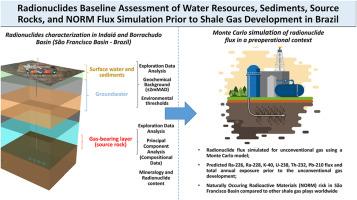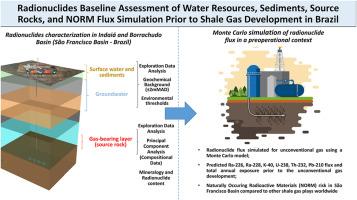巴西页岩气开发前水资源、沉积物、烃源岩的放射性核素基线评估和NORM通量模拟
IF 7.3
2区 环境科学与生态学
Q1 ENVIRONMENTAL SCIENCES
引用次数: 0
摘要
水力压裂是一种有争议但有利可图的非常规油气开采技术。与水力压裂法有关的一个重大环境问题是它可能调动放射性核素,导致含水层、沉积物和地表水受到污染。尽管存在这种风险,但由于非常规油气作业而导致的流域放射性核素污染的可能性往往被低估,从而在全球范围内造成危险后果,包括健康风险和生态系统破坏。降低此类风险的一种有效方法是在页岩气开发之前建立环境基线。本研究的目的是在引入非常规天然气生产之前,为本文章由计算机程序翻译,如有差异,请以英文原文为准。


Radionuclides baseline assessment of water resources, sediments, source rocks, and NORM flux simulation prior to shale gas development in Brazil
Hydraulic fracturing (fracking) is a controversial yet profitable technique used to stimulate ultra-low permeability reservoirs in unconventional hydrocarbon production. A significant environmental concern associated with fracking is its potential to mobilize radionuclides, leading to contamination aquifers, sediments, and surface waters. Despite this risk, the potential for radionuclide contamination in watersheds due to unconventional oil and gas operations is frequently underestimated, resulting in hazardous consequences globally, including health risk and ecosystem damage. One effective approach to mitigating such risks is establishment of environmental baselines prior to shale gas development. This study aims to establish a radionuclide baseline for surface water, groundwater, sediments, and source rocks in the São Francisco Basin (Brazil), prior to the introduction of unconventional gas production. The study also simulates radionuclide flux in produced water, a byproduct of hydraulic fracturing, and assesses annual dose of radioactivity exposure using Monte Carlo simulations. Radionuclides U-238, Th-232, K-40, Pb-210, Ra-226, and Ra-228 were analyzed using Neutron Activation Analysis (NAA) and gamma spectrometry. Environmental thresholds and geochemical background were calculated using 2mMAD (Median Absolute Deviation) whereas a multivariate statistical analysis was performed through Principal Components Analysis using Compositional Data transformations. A Monte Carlo simulation, based on 10,000 iterations, was used to compare potential NORM flux from fracking with natural background levels and those in other shale plays worldwide. Current radionuclide concentrations in water resources are low, however the NORM flux and Annual Exposure simulations indicate a potential radiological risk to water security in the event of unconventional gas production. This research provide novel insights into the NORM-related risks of fracking in the São Francisco Basin, offering a foundation for further assessments before shale gas development, which can be also used in unconventional reservoirs around the world.
求助全文
通过发布文献求助,成功后即可免费获取论文全文。
去求助
来源期刊

Environmental Pollution
环境科学-环境科学
CiteScore
16.00
自引率
6.70%
发文量
2082
审稿时长
2.9 months
期刊介绍:
Environmental Pollution is an international peer-reviewed journal that publishes high-quality research papers and review articles covering all aspects of environmental pollution and its impacts on ecosystems and human health.
Subject areas include, but are not limited to:
• Sources and occurrences of pollutants that are clearly defined and measured in environmental compartments, food and food-related items, and human bodies;
• Interlinks between contaminant exposure and biological, ecological, and human health effects, including those of climate change;
• Contaminants of emerging concerns (including but not limited to antibiotic resistant microorganisms or genes, microplastics/nanoplastics, electronic wastes, light, and noise) and/or their biological, ecological, or human health effects;
• Laboratory and field studies on the remediation/mitigation of environmental pollution via new techniques and with clear links to biological, ecological, or human health effects;
• Modeling of pollution processes, patterns, or trends that is of clear environmental and/or human health interest;
• New techniques that measure and examine environmental occurrences, transport, behavior, and effects of pollutants within the environment or the laboratory, provided that they can be clearly used to address problems within regional or global environmental compartments.
 求助内容:
求助内容: 应助结果提醒方式:
应助结果提醒方式:


